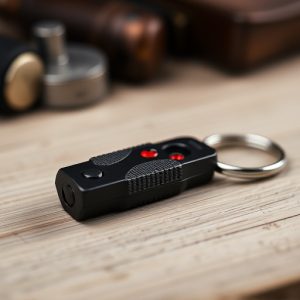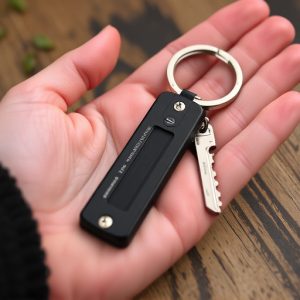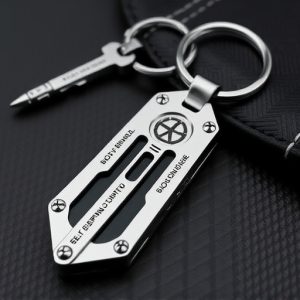Portable Keychain Weapons: Safety Features & Effective Use Cases
Mastering keychain pressure point defense moves enhances self-defense capabilities of portable tools…….
Mastering keychain pressure point defense moves enhances self-defense capabilities of portable tools, enabling swift and safe neutralization of attackers in close quarters while adhering to legal guidelines. Choosing keychains with safety features, durable materials, and built-in locks is crucial. These tools offer discreet, convenient protection, especially beneficial for women and high-risk areas, giving users confidence to respond to unexpected threats. Legal considerations and ethical responsible ownership are vital, emphasizing training in de-escalation techniques to use these compact weapons as a last resort.
In today’s world, personal safety is paramount. One innovative solution gaining traction is the portable keychain weapon, designed for easy carrying and self-defense. This article explores the critical aspects of keychain pressure point defense moves, delving into safety features to consider when choosing such a device. We’ll also discuss effective use cases and the legal and ethical considerations surrounding their carriage, providing a comprehensive guide for those seeking enhanced personal security.
- Understanding Keychain Pressure Point Defense Moves
- Safety Features to Consider When Choosing a Keychain Weapon
- Effective Use Cases for Portable Keychain Weapons
- Legal and Ethical Considerations for Carrying Self-Defense Keychains
Understanding Keychain Pressure Point Defense Moves
Understanding Keychain Pressure Point Defense Moves is a crucial aspect of leveraging your portable keychain weapon effectively. These moves focus on applying precise pressure to sensitive areas of an attacker’s body, neutralizing them quickly and safely. By learning basic techniques, you can defend yourself in close-quarters situations with surprising agility and force.
Keychain Pressure Point Defense Moves are designed for self-defense scenarios where every second counts. They allow you to mitigate threats without causing permanent harm, adhering to legal constraints around self-defense. With practice, these moves become instinctive, empowering you to react calmly and decisively when faced with danger.
Safety Features to Consider When Choosing a Keychain Weapon
When selecting a keychain weapon, safety features should be your top consideration. Look for designs that incorporate reliable locking mechanisms to prevent accidental deployment. The ability to quickly and discreetly activate pressure point defense moves is crucial—these small but powerful tools can help you defend yourself in close-quarters situations.
Consider materials that offer durability without compromising comfort or ease of use. A well-constructed keychain weapon should be easy to handle, allowing for quick reflexes in stressful scenarios. Additionally, ensure it comes with safety features like a built-in safety lock or a simple yet effective disengagement mechanism to avoid unintended consequences during training or everyday carry.
Effective Use Cases for Portable Keychain Weapons
Portable keychain weapons, designed for self-defense, offer a discreet and convenient way to empower individuals with personal safety tools. Their compact size makes them ideal for situations where one might need a quick response, such as in close-quarter encounters or when facing unexpected threats. Effective use cases include teaching individuals essential pressure point defense moves, which can incapacitate an attacker temporarily, giving the user precious time to escape or summon help.
These tiny tools can be particularly useful for women who often find themselves alone in public spaces or for individuals living in high-crime areas. By mastering a few keychain weapon techniques, users can boost their confidence and gain a sense of control over their safety. Keychain pressure point defense moves teach individuals to target specific vulnerable areas on an attacker’s body, ensuring that even a small device can pack a powerful punch when used correctly.
Legal and Ethical Considerations for Carrying Self-Defense Keychains
Carrying a keychain as a self-defense tool raises important legal and ethical considerations, especially for individuals in regions where open carry laws vary significantly. The legality of such devices often hinges on their design and intended use. While some areas permit defensive tools so long as they are not readily visible or capable of causing serious harm, others have stringent regulations, classifying any self-defense device as a weapon.
Ethically, the discussion shifts to responsible ownership and the potential consequences of using keychain pressure point defense moves. These compact weapons can be life-saving in dangerous situations, but their usage must be justified and proportionate. Users should be well-trained in effective yet non-lethal techniques, prioritizing de-escalation over immediate force. Safety guidelines and education are paramount to ensuring these devices serve as a last resort rather than a cause for heightened concern or legal repercussions.
When considering a portable keychain weapon, prioritizing safety features is paramount. Understanding keychain pressure point defense moves and legal implications ensures responsible carrying. Choose models with secure locking mechanisms and durable construction for effective self-defense in unexpected situations. Always remember to act within ethical boundaries and comply with local regulations regarding self-defense tools.


